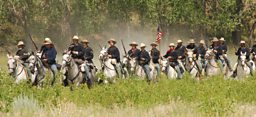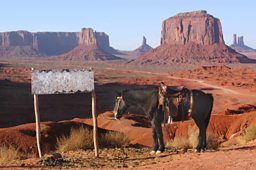Steven Knight’s six facts about Sitting Bull
Steven Knight, the screen writer and director of Peaky Blinders and Taboo, has an all-time hero. As a young teenager growing up in Birmingham in the 1970s, he was obsessed with Native Americans. At the age of 13, he searched for pen pals and ended up exchanging trans-Atlantic letters with the great grandchildren of Sitting Bull. The friendship has continued into his adult life, as has his love of the legendary Sitting Bull, the Hunkpapa Lakota holy man who led his people through years of resistance to United States government policies.
Steven discusses Sitting Bull’s legacy in Radio 4’s Great Lives, where he is joined by Jacqueline Fear-Segal, Professor of American and Indigenous Histories at the University of East Anglia.

1. Sitting Bull's childhood nickname was 'Slow'
At birth, Sitting Bull was named Jumping Badger. But his nickname as a child was Hunkesi, meaning 'Slow', because he always took time to think before answering a question.
He was finally assigned his eponymous Sitting Bull title after killing his first buffalo on a hunt as a young teenager. Upon returning to camp, his father put on a celebratory feast at which he passed down his own name onto his son. His name meant 'Buffalo Bull Who Sits Down' in the Lakota language, later abbreviated to 'Sitting Bull'.

The different names of Sitting Bull
Screen writer and director Steven Knight talks about Sitting Bull.
2. Sitting Bull smoked his way to a brave reputation
The story goes that, in 1872, when the Sioux clashed with the U.S. Army trying to block construction of the Northern Pacific Railroad, Sitting Bull walked calmly into the open and took a seat on the soldier's front lines. He sat down, filled his pipe, smoked it, cleaned the pipe, and then slowly walked back to his warriors without being hit by a single bullet.
Valiant? Or just lucky? It's hard to know. But his nephew White Bull later hailed the act as “the bravest deed possible.”
3. Sitting Bull predicted Custer’s defeat
Remembered as a warrior and political leader, Sitting Bull was also believed to be a holy man who possessed the gift of spiritual prophecy. At a Sun Dance in June 1876, he ceremonially cut pieces of flesh from his arms and fell into a trance, from which he recounted a vision of soldiers invading Lieutenant Colonel George A. Custer's camp like a cloud of grasshoppers falling from the sky.
Just weeks later, Custer's defeat at the Battle of the Little Big Horn played out his vision, also referred to as 'Custer's Last Stand'. By almost all accounts, the Lakota tribe annihilated Custer's force within an hour.

4. Sitting Bull was joked about in the House of Commons
Sitting Bull's reputation soon spread across the pond to British turf. When Sitting Bull was in exile in Canada, his presence was raised in a Commons debate. A Minister said that the United States wanted him to be returned as a wanted criminal. According to Hansard, the verbatim report from the Houses of Commons and Lords, a politician piped up: "if he is a Sitting Bull, how can he be expected to move?" Those were the jokes in 1888.
5. Sitting Bull joined Buffalo Bill’s Wild West circus
After release from prison, Sitting Bull joined Buffalo Bill’s Wild West circus as a performer and toured the east, including New York. Here, he was shocked by the poverty he saw. He said "the white man knows how to make everything, but doesn’t know how to share it out."
6. Sitting Bull's assassination caused his horse to dance
Buffalo Bill gave Sitting Bull a circus horse called Rico. The horse was trained to dance and fall to the floor when hearing gun shots. Legend has it that the horse danced and fell to the ground when Sitting Bull was assassinated outside his cabin by Indian agency police in December 1890.
Those watching believed it was a sign that the Indian Messiah was coming. Many of his people ran away, but they were pursued by the Seventh cavalry to a place called Wounded Knee where almost three hundred men, women and children were massacred by newly invented machine guns.
A monument to Sitting Bull was erected at his birthplace near Mobridge, South Dakota, in 1953.

-
![]()
Great Lives
Steven Knight on Sitting Bull
-
![]()
Crossing Continents
Native Americans in the US Military
-
![]()
In Our Time
The American West
-
![]()
In Our Time
The life of Pocahontas




